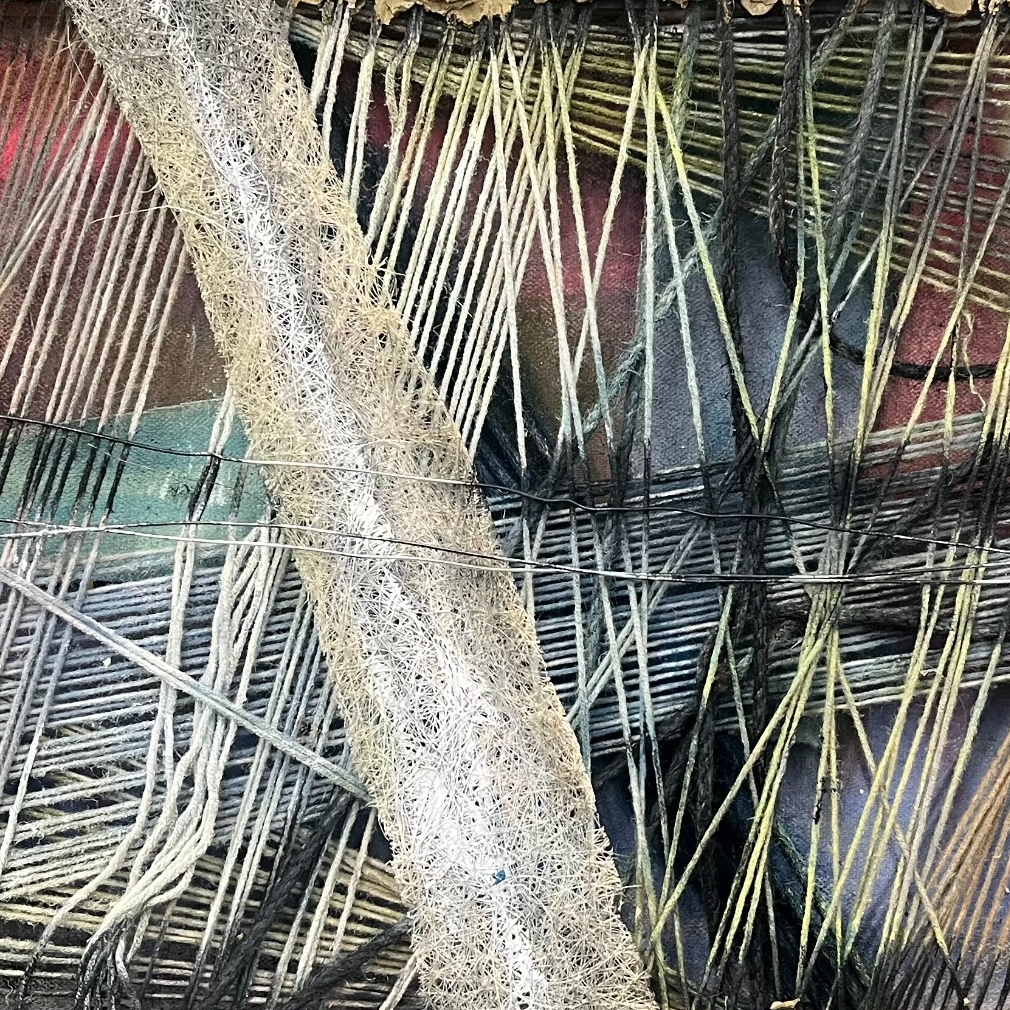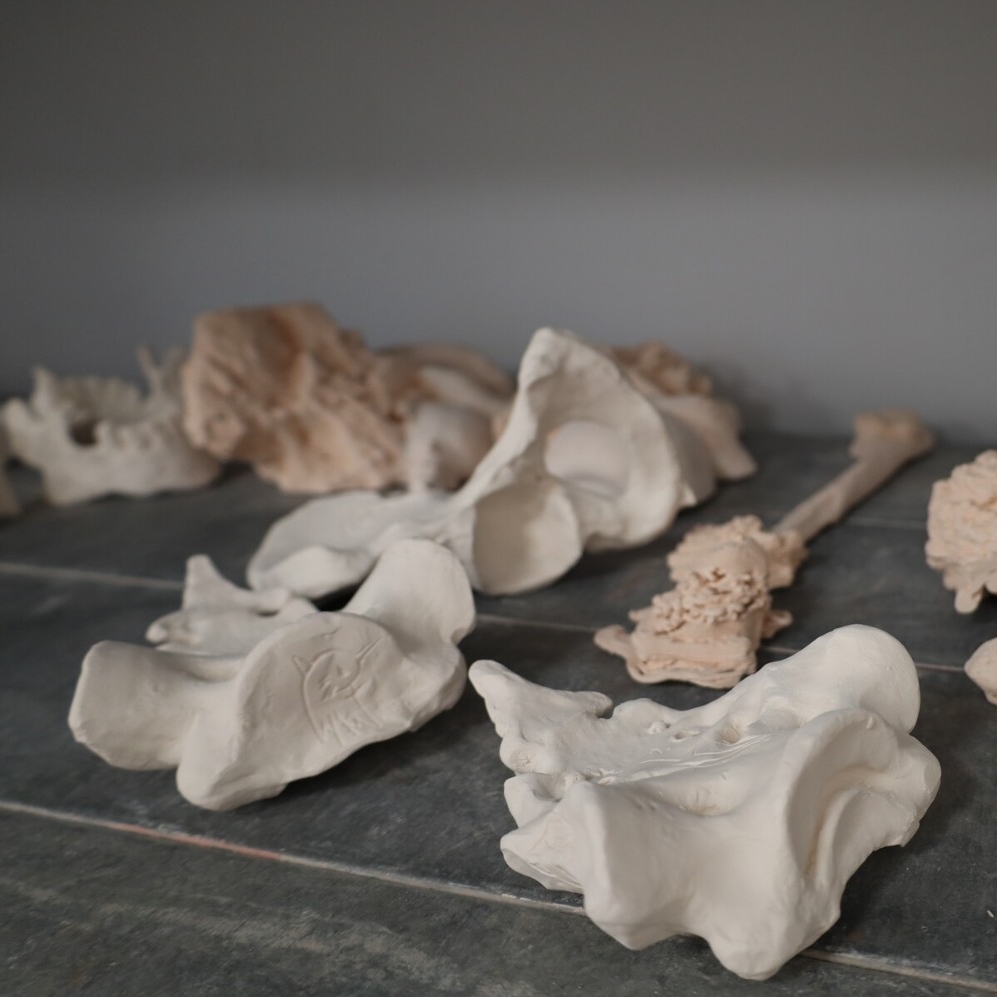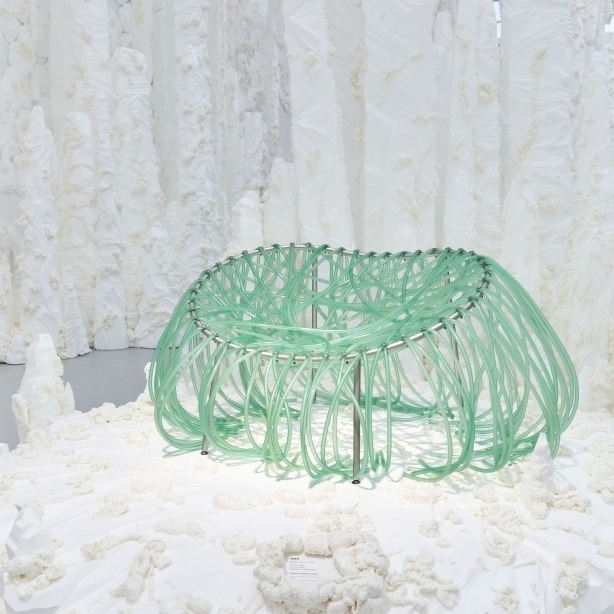 Ruth Asawa with life masks on the exterior wall of her house. Image credit: Photography by Terry Schmitt. ARTWORK: Untitled (LC.012, Wall of Masks), c. 1966–2000. Ceramic, bisque-fired clay. © 2020 Estate of Ruth Asawa/ Artists Rights Society (ARS), New York. Courtesy The Estate of Ruth Asawa and David Zwirner)
Ruth Asawa with life masks on the exterior wall of her house. Image credit: Photography by Terry Schmitt. ARTWORK: Untitled (LC.012, Wall of Masks), c. 1966–2000. Ceramic, bisque-fired clay. © 2020 Estate of Ruth Asawa/ Artists Rights Society (ARS), New York. Courtesy The Estate of Ruth Asawa and David Zwirner)
In 2019, Aiko and Laurence Cuneo came down to the Cantor Arts Center at Stanford University to help oversee the installation of one of Ruth Asawa’s abstract wire sculptures. Aleesa Pitchamarn Alexander, the Cantor’s assistant curator of American art, was including the piece in a rotation of exhibition, The Medium Is the Message: Art since 1950. During installation, Aiko, Asawa’s daughter, asked Alexander if she knew about the hundreds of ceramic face masks that used to hang on their family home’s exterior. From the mid-1960s through 2000, Asawa created individual masks out of clay.
“Though I had been an admirer of Asawa’s work for a long time,” Alexander recounted, “I had never heard of these masks or her ceramic work. Once Aiko and Laurence showed me some pictures, I was amazed—these masks, cast from the faces of friends and family—completely expanded my understanding of Asawa’s practice. It demonstrated to me that community engagement was an essential part of her world and artistic output.”
In the ensuing months, Alexander continued the conversation about the masks with the estate of Ruth Asawa. For a long time, the masks were considered ephemera—not an official part of the artist’s output. Eventually, it became clear to the family that not only did these objects help tell a fuller, more complete version of Asawa’s life, but also their aesthetic impact was of unique significance. However, it was unclear where these masks would find a permanent home.
During this time, the Cantor was preparing to launch the Asian American Art Initiative (AAAI), which would transform Stanford into the leading academic and curatorial center for Asian American art. Alexander and Marci Kwon, assistant professor in Stanford’s Department of Art and Art History, would serve as AAAI co-directors. As part of the initiative, the Cantor was working to build the preeminent collection of Asian American art at a university art museum. With the AAAI in mind and the fact that Stanford Libraries Department of Special Collections house Ruth Asawa’s archive, it seemed like the Cantor was the perfect place for Untitled (LC.012, Wall of Masks), Asawa’s 233 ceramic masks.
The Cantor acquired Untitled (LC.012, Wall of Masks) in 2020. On July 6, 2022, they will go on long-term view at the museum, marking the first time this work has been shown in its entirety at any museum or public institution. The focused exhibition, The Faces of Ruth Asawa, curated by Alexander, will feature the masks and three vessels by Asawa’s son Paul Lanier. These special vessels were created with clay mixed with the ashes of Asawa, her husband Albert, and their late son, Adam. Upon Asawa’s death—per her request—Lanier took this material and threw a set of vessels, one for each remaining sibling. The three included in The Faces of Ruth Asawa were borrowed from the family. Their inclusion in the exhibition further demonstrates Asawa’s deeply intimate connection to clay.
“The Faces of Ruth Asawa is a unique exhibition,” Alexander said. “If museum visitors know about her, they likely know of her hanging biomorphic wire sculptures. With this installation, you are not only getting a glimpse into a different side of Asawa’s practice but a distinct view of the Bay Area arts community during the last half of the 20th century.”
“To me,” Alexander states, “Asawa’s life has long served as a paragon of what a meaningful existence can be. She was a creative spirit to the highest degree—but not only that, she never forgot about the other elements that make life worth living: family, community, and the preservation of history. I hope this installation effectively captures her spirit and inspires others, as she has inspired me.”
The Faces of Ruth Asawa is one of three exciting exhibitions related to the Asian American Art Initiative opening at the Cantor in 2022. At Home/On Stage: Asian American Representation in Photography and Film opens Aug. 31, and East of the Pacific: Making Histories of Asian American Art opens Sept. 28.
About the artist
Ruth Asawa was born in Norwalk, Calif., in 1926 and spent the early part of her life on her parent's farm with her six siblings. During WWII, her family was interned as part of Executive Order 9066. After graduating from high school in an incarceration camp, she attended Milwaukee State Teachers College but could not obtain a degree due to her Japanese ancestry. From 1946 to 1949, she attended the historically significant art school, Black Mountain College, in North Carolina. There she studied with Josef Albers and met her future husband, Albert Lanier. Asawa and Lanier moved to San Francisco, where they would remain for the rest of their lives. Asawa continued her sculptural practice in San Francisco while also serving as an important arts advocate. She has ten public sculptures in the Bay Area, served on the San Francisco Arts Commission, helped establish the San Francisco School of the Arts (now Ruth Asawa San Francisco School of the Arts), and was the first artist to serve on the Board of Trustees for the Fine Arts Museums of San Francisco. She continued to make art until the early 2000s and died in 2013. The Cantor has one hanging tied-wire sculpture by Asawa in its collection (2014.110).
Courtesy the Cantor Arts Center at Stanford University.




























